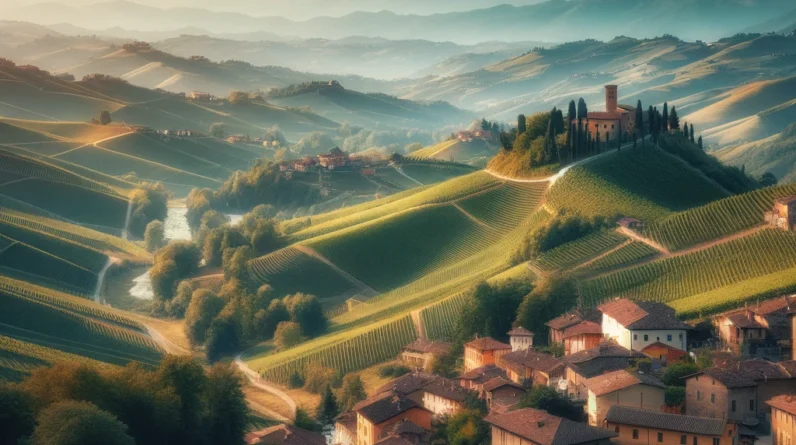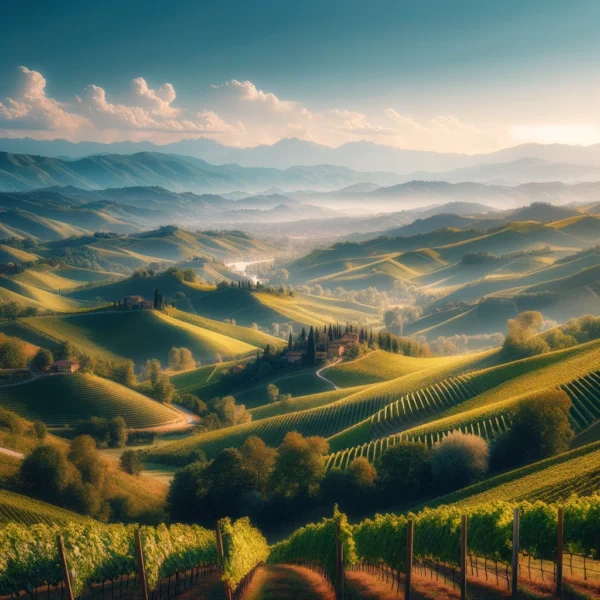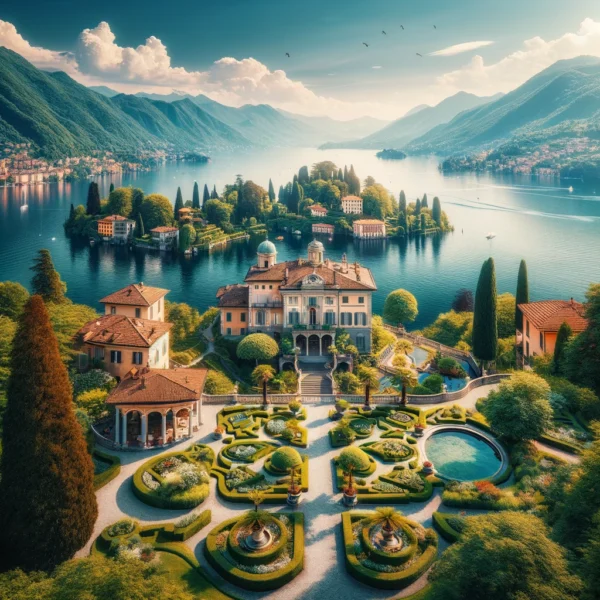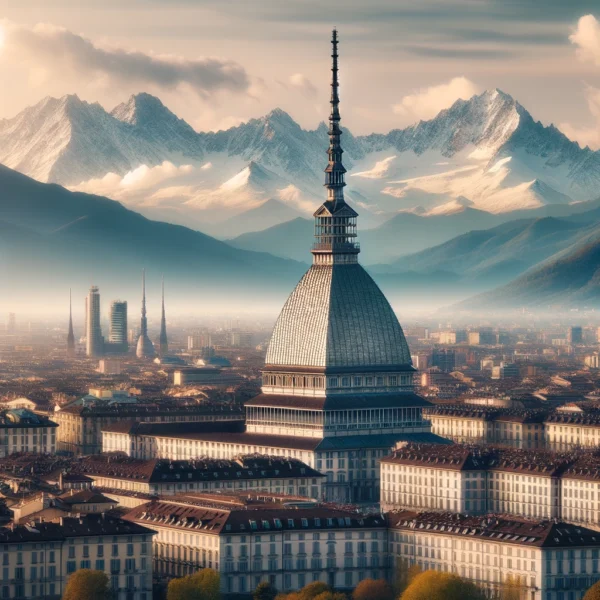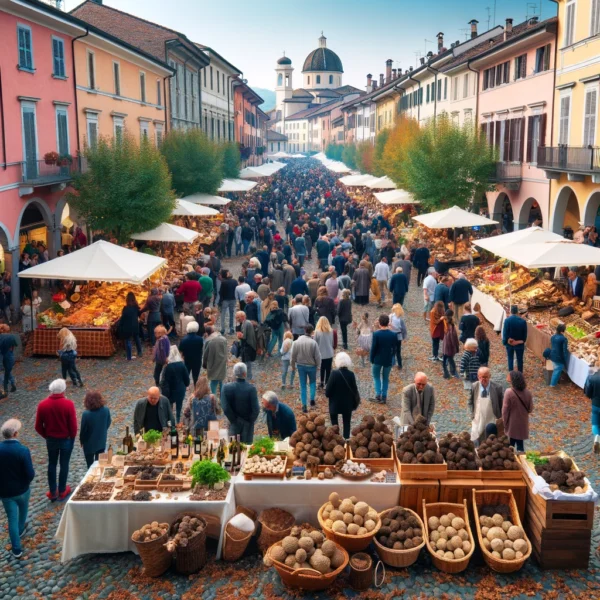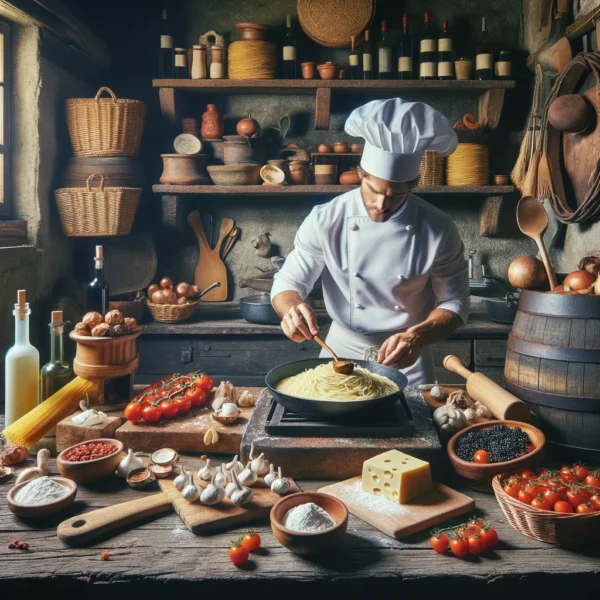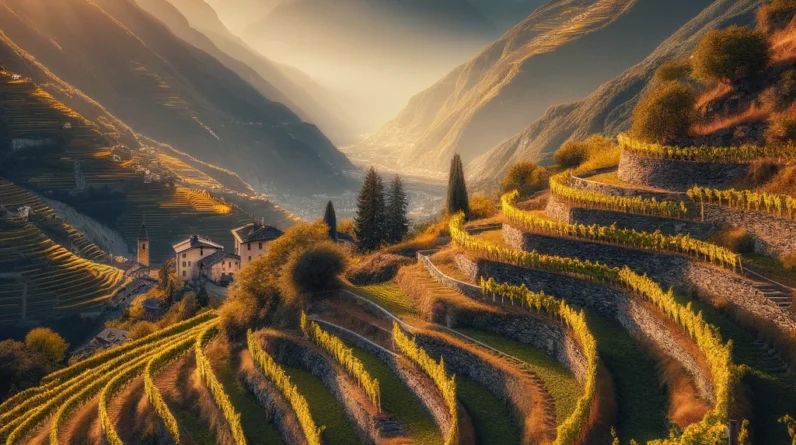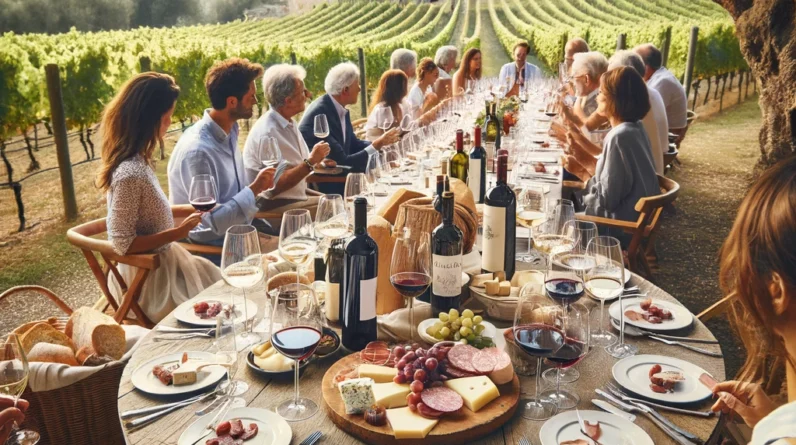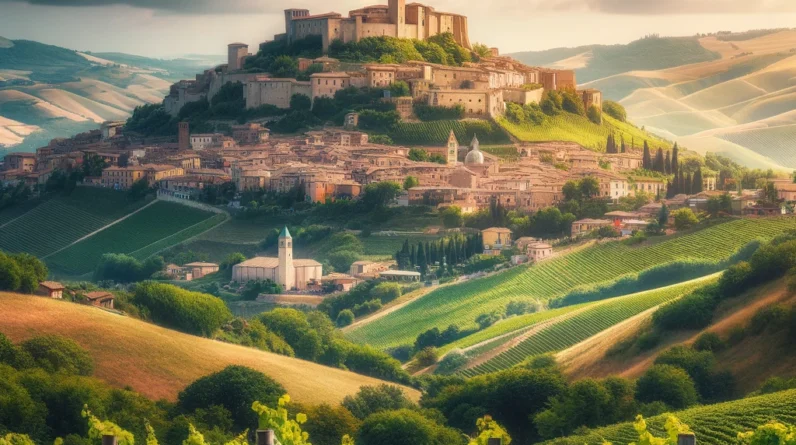Piemonte wines hold a special place in the world of viticulture for several compelling reasons.
Piemonte’s unique geographical location, nestled at the foothills of the Alps, creates a distinctive terroir.
The combination of altitude, microclimate, and soil variety contributes to the production of wines with remarkable complexity and depth.
The region is home to the noble Nebbiolo grape, the cornerstone of the prestigious Barolo and Barbaresco wines.
Nebbiolo is celebrated for its ability to produce wines of great aging potential and complexity.
Besides Nebbiolo, Piemonte is also known for other varieties like Barbera, Dolcetto, and Moscato, each bringing its unique character to the region’s wine profile.
Piemonte has a deeply rooted winemaking history that dates back centuries.
This tradition has been preserved and passed down through generations, ensuring that each bottle of wine is a testament to time-honored techniques blended with modern innovation.
From the robust and tannic reds like Barolo and Barbaresco to the sweet and sparkling Moscato d’Asti, Piemonte offers a diverse range of wines.
This variety ensures that the region has something to offer for every palate.
Many of Piemonte’s wines, particularly those made from Nebbiolo, are known for their exceptional aging potential.
These wines can develop more nuanced flavors and aromas over time, making them highly sought after by collectors and enthusiasts.
Piemonte wines are consistently ranked among the best in the world, receiving international acclaim for their quality and craftsmanship.
The complexity and variety of Piemonte wines make them excellent companions to food.
They pair wonderfully with the rich and varied cuisine of the region, from truffle-infused dishes to hearty stews and pastas.
Wine is an integral part of Piemonte’s cultural identity.
The region’s wine festivals, traditions, and the very landscape of vine-covered hills are a testament to the importance of winemaking in the local way of life.
In essence, Piemonte wines are not just beverages; they are a synthesis of rich history, unique terroir, and dedicated craftsmanship, each bottle telling a story of a land and its people.
This is what makes them truly special and a jewel in the crown of global viticulture.
Wine Tasting and Tours
The region offers a plethora of wine-tasting experiences and guided tours.
Visitors can explore ancient cellars, meet winemakers, and sample exquisite wines right where they’re produced.
Many vineyards offer personalized tours, giving insights into the winemaking process, from grape harvesting to aging.
The towns of Alba and Asti are great starting points for these tours, offering a blend of historical sites and wine-tasting opportunities.
The Piemonte region, known for its stunning landscapes, rich history, and exquisite cuisine, offers a myriad of places to visit and explore.
Alba
Often referred to as the gastronomic capital of Piemonte, Alba is famous for its white truffles, wines, and delightful medieval center.
Don’t miss the annual Alba White Truffle Festival if you’re visiting in the fall.
Turin (Torino)
The regional capital, known for its refined architecture, grand boulevards, and the renowned Egyptian Museum.
Turin also boasts beautiful baroque buildings, lively piazzas, and excellent dining options.
The Langhe Wine Region
A UNESCO World Heritage site, famous for its picturesque landscapes dotted with vineyards and charming villages.
It’s the home of Barolo and Barbaresco wines. The towns of Barolo, La Morra, and Neive are must-visits.
Asti
Known for its sparkling wine, Asti is a city with a rich history.
The annual Palio di Asti, Italy’s oldest horse race, and the Festival delle Sagre, a celebration of local food and wine, are highlights.
The Royal Palace of Venaria
A magnificent example of Baroque art, located just outside Turin, it’s one of the largest royal residences in the world and part of the UNESCO World Heritage list.
Lake Maggiore and the Borromean Islands
Offering stunning views and beautiful gardens, the islands are a perfect day trip to enjoy natural beauty and relaxation.
The Sacri Monti (Sacred Mountains)
A series of nine groups of chapels and other architectural features created in the late 16th and 17th centuries, dedicated to different aspects of Christian faith.
Bra
The heart of the Slow Food movement and a haven for food enthusiasts.
It’s an ideal place to enjoy the regional cuisine in a less touristy setting.
The Forte di Fenestrelle
Known as the “Great Wall of the Alps”, this impressive fort is a marvel of military architecture and offers breathtaking views of the surrounding valleys.
Baroque Architecture in Cherasco
This historic town is not only known for its snail farming but also for its well-preserved baroque architecture, offering a glimpse into the region’s past.
Each of these places in Piemonte offers a unique experience, combining natural beauty, historical richness, and gastronomic excellence, making them ideal for travelers looking to immerse themselves in the authentic Italian culture and lifestyle.

Practical Tips on Visiting Piemonte
Visiting the Piemonte region in Italy can be a delightful experience, enriched by its cultural, culinary, and scenic offerings.
Best Time to Visit
Autumn is a fantastic time, especially during the grape harvest and the Alba White Truffle Festival.
However, spring and early summer are also great for enjoying the scenic beauty and outdoor activities.
Transportation
Renting a car is highly recommended for exploring the countryside, especially the vineyards.
While public transport is available, it’s less frequent in rural areas.
Having a car offers flexibility and ease of access to remote locations.
Language
While English is spoken in tourist areas, learning some basic Italian phrases will enrich your experience, especially in rural areas or smaller towns.
Winery Visits
Plan and book your winery visits in advance.
Many smaller wineries require appointments for tastings and tours.
Accommodation
Consider staying in agriturismos (farm stays) for an authentic Piemontese experience.
These often offer excellent local cuisine and a more intimate look at the region’s way of life.
Local Cuisine
Don’t miss out on trying local specialties such as tajarin, vitello tonnato, and dishes featuring the famed white truffles.
Remember, food is a cornerstone of Piemonte’s culture.
Cultural Etiquette
Italians generally dine late, so expect dinner service to start around 8 PM.
Also, meals are often leisurely affairs, meant to be savored.
Local Markets
Explore local markets for fresh produce, cheeses, and other regional specialties.
They are vibrant places to understand local life and cuisine.
Dress Code
Italians are known for their style.
While there’s no strict dress code, smart casual wear is generally appreciated, especially when dining out in nicer restaurants.
Weather Preparedness
The weather can vary, especially with the region being close to the Alps.
It’s wise to pack layers and be prepared for changing conditions.
Stay Connected
Purchasing a local SIM card can be very useful for navigation, especially in rural areas where Wi-Fi may not always be readily available.
Cash and Cards
While credit cards are widely accepted, it’s good to have some cash, especially for smaller purchases in rural areas or at local markets.
Remember, every trip is an opportunity for new experiences.
Be open to spontaneous discoveries, whether it’s a small local winery, a village festival, or a scenic detour.
Piemonte offers a wealth of treasures for those who are willing to explore!

Wine Purchasing and Export
Piemonte is not just a haven for wine lovers to visit; it’s also a significant source of wines for international markets.
Many vineyards offer direct purchasing options, and some specialize in exporting their wines globally.
This makes it possible for wine enthusiasts around the world to savor a piece of Piemonte at home.
The Best Vintages in Piemonte
Determining the “best” vintages in Piemonte, especially for wines like Barolo and Barbaresco, depends on various factors, including weather conditions during the growing season and harvest, winemaker decisions, and aging potential.
However, there are certain years that have gained widespread acclaim for producing exceptional wines in the region.
Notable Vintages for Barolo and Barbaresco
- 1990: An exceptional vintage, marked by wines with great concentration, depth, and the potential to age gracefully for decades.
- 1996: A classic vintage, known for producing very structured and age-worthy wines, though they required some patience to reach their peak.
- 2001: Renowned for its high quality, the 2001 vintage brought wines with great structure, complexity, and aging capability.
- 2004: This vintage produced wines with excellent structure and balance, making them highly sought after by collectors.
- 2010: An outstanding year, characterized by a perfect balance of structure, tannins, and acidity.
Wines from this vintage are known for their longevity and complexity. - 2016: A stellar vintage, praised for its ideal growing conditions.
The wines are marked by depth, elegance, and excellent aging potential.
Recent Vintages to Watch
- 2013: A vintage that produced more traditional, classic style wines with high acidity and tannin, ideal for long-term aging.
- 2015: Considered a very good year with balanced wines showing good potential for aging.
- 2019 & 2020: While still relatively young, these vintages have shown promise and might turn out to be excellent as they mature.
Factors Influencing Vintage Quality
Weather Conditions: nIdeal weather conditions during key growth stages, like a warm summer and a dry harvest season, contribute significantly to the quality of the vintage.
Winemaker Decisions: The skill and choices of the winemaker in vineyard management and wine production also play a crucial role in the quality of the vintage.
Aging Potential: Some vintages may not show their full potential immediately and may require several years of aging to fully develop their flavors and complexity.
It’s important to remember that each vintage can vary significantly, and while certain years are acclaimed, individual producers may excel in different years.
Wine enthusiasts often enjoy exploring various vintages to appreciate the nuances and diversity that each year brings to Piemonte wines.

Regional Specialties and Pairings
The cuisine of Piemonte complements its wines beautifully.
Dishes like truffle-laden risottos, rich stews, and meat-filled pastas are perfect with the region’s robust reds.
The lighter whites pair wonderfully with Piemonte’s cheeses and fish dishes.
Understanding these pairings can elevate the dining experience, blending flavors in harmony.
Piemonte, a region celebrated for its rich culinary traditions, offers an array of delectable dishes that pair wonderfully with its varied wines.
Tajarin al Tartufo (Truffle Pasta)
This delicate, egg-rich pasta topped with shavings of the prized white truffles of Alba is a regional specialty.
Pair it with a Barbaresco or a mature Barolo, whose earthy notes complement the truffle’s intense aroma.
Brasato al Barolo (Beef Braised in Barolo)
A hearty dish where beef is slow-cooked in Barolo wine, creating a rich, flavorful sauce.
Naturally, a glass of Barolo is the perfect match, echoing the deep, complex flavors in the dish.
Vitello Tonnato (Veal with Tuna Sauce)
A unique combination of thinly sliced veal covered in a creamy tuna sauce.
This dish pairs nicely with a light, refreshing white like Gavi, or a young, fruity Barbera.
Agnolotti del Plin
Small, pinched ravioli filled with a mix of meats and herbs.
This pasta dish goes well with a variety of reds, but a Barbera d’Asti, with its bright acidity and moderate tannins, is a classic choice.
Bagna Càuda
A warm dip made with garlic, anchovies, and olive oil, traditionally served with raw or cooked vegetables.
A vibrant Dolcetto or a crisp Roero Arneis are excellent companions to this flavorful dish.
Bonet
A chocolate and amaretti custard dessert.
It can be wonderfully paired with a sweeter wine like Moscato d’Asti, whose light bubbles and sweetness balance the richness of the dessert.
Hazelnut Cake (Torta di Nocciole)
Piemonte is famous for its hazelnuts.
A simple, nutty cake made from them pairs delightfully with a slightly sweet, sparkling Brachetto d’Acqui.
These dishes and their wine pairings highlight the interplay between Piemonte’s culinary and vinicultural traditions, creating a gastronomic experience that is both uniquely regional and universally appealing.
In conclusion, Piemonte’s wines and vineyards represent a rich tapestry of history, culture, and gastronomy.
Whether you’re exploring the nuanced flavors of its wines, wandering through its historic vineyards, or indulging in its culinary delights, Piemonte offers a truly immersive experience for the senses.
For anyone passionate about wine, a journey through Piemonte is both enlightening and unforgettable.
FAQs:
Q1: What are the most famous wines from Piemonte?
A1: Piemonte is renowned for Barolo and Barbaresco wines, made from the Nebbiolo grape.
Other notable wines include Barbera, Dolcetto for reds, and Moscato d’Asti and Gavi for whites.
Q2: Can I visit vineyards in Piemonte for wine tasting?
A2: Yes, many vineyards in Piemonte offer wine tasting and tours.
It’s a fantastic way to experience the region’s wine culture and learn about winemaking.
Q3: What is the best time to visit Piemonte for wine lovers?
A3: Fall is an excellent time to visit, especially during the harvest season and the Alba White Truffle Festival.
However, spring and summer also offer beautiful vineyard landscapes and pleasant weather.
Q4: Are Piemonte wines expensive?
A4: The price range varies. While Barolo and Barbaresco can be on the higher end, there are many quality wines like Barbera and Dolcetto that are quite affordable.
Q5: What makes Piemonte wines unique?
A5: The unique combination of the region’s terroir, climate, and traditional winemaking methods contribute to the distinct flavors and high quality of Piemonte wines.
Q6: What food pairs well with Piemonte wines?
A6: Hearty dishes like truffle-based recipes, risottos, and meat stews pair beautifully with Piemonte reds.
Lighter whites like Arneis and Gavi are great with seafood and soft cheeses.
Q7: Is Piemonte suitable for wine tourism beyond tasting?
A7: Absolutely. Piemonte offers a rich cultural experience with historic vineyards, charming towns, and a range of festivals and events centered around wine.
Q8: How does the climate in Piemonte affect its wines?
A8: The continental climate, with cold winters and warm summers, allows grapes to ripen slowly, enhancing the flavor complexity and aromatic quality of the wines.
Q9: Are there any organic or biodynamic vineyards in Piemonte?
A9: Yes, there’s a growing trend towards organic and biodynamic practices in Piemonte, with several vineyards adopting these sustainable methods.
Q10: Can I buy Piemonte wines directly from the vineyards?
A10: Many vineyards offer direct sales and even shipping options.
It’s a great way to acquire some exclusive bottles and support local winemakers.
